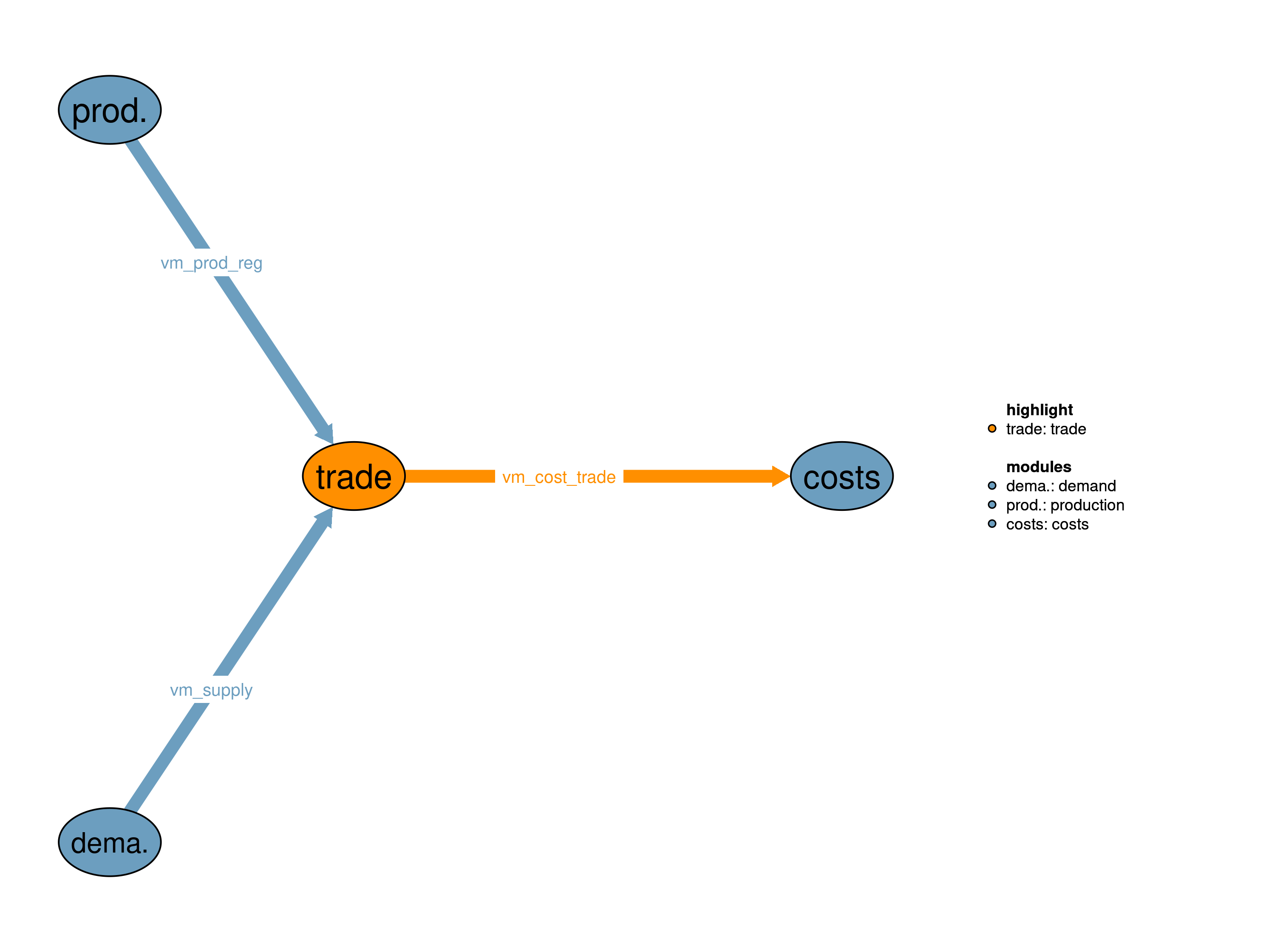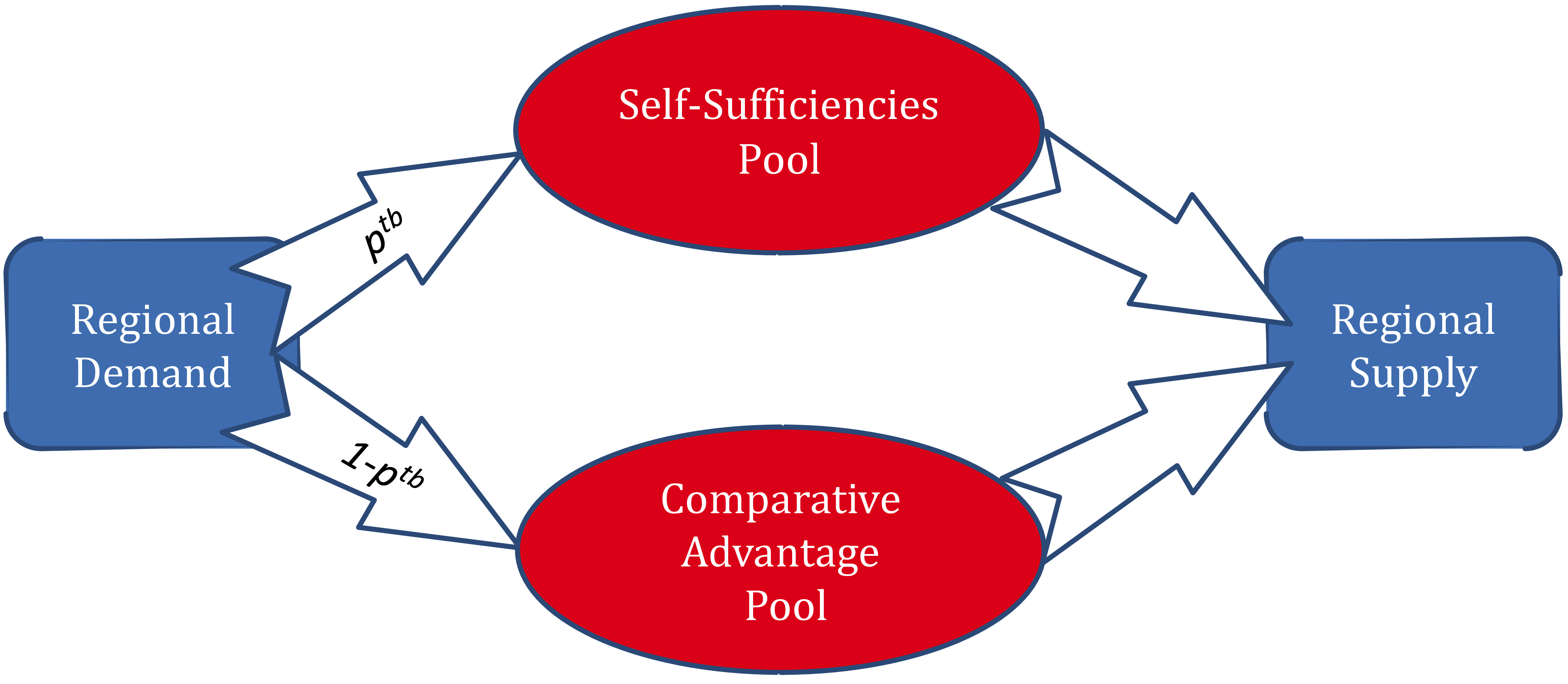This module represents agricutlural trade among world regions. It ensures that the regional demand is met by domestic production and imports from other regions. The global trade balance dictates that global production must be larger than or equal to global demand. For non-traded goods, the regional production must be larger than or equal to regional demand.

| Description | Unit | A | B | C | |
|---|---|---|---|---|---|
| vm_prod_reg (i, kall) |
Regional aggregated production | \(10^6 tDM/yr\) | x | x | x |
| vm_supply (i, kall) |
Regional demand | \(10^6 tDM/yr\) | x | x | x |
| Description | Unit | |
|---|---|---|
| vm_cost_trade (i) |
Regional trade costs | \(10^6 USD_{05MER}/yr\) |
In this realization, agricultural trade is fully liberalized in all timesteps.
\[\begin{multline*} \sum_{i2 }vm\_prod\_reg(i2,k\_trade) \geq \sum_{i2} vm\_supply(i2,k\_trade) \end{multline*}\]
\[\begin{multline*} vm\_prod\_reg(i2,k\_notrade) \geq vm\_supply(i2,k\_notrade) \end{multline*}\]
Limitations This realization does not account for current trends in agricultural trade.
In this realization, there is no agricultural trade, i.e. regions are fully self-sufficient and dependent on domestic production.
\[\begin{multline*} vm\_prod\_reg(i2,k) \geq vm\_supply(i2,k) \end{multline*}\]
Limitations This realization does not account for current trends in agricultural trade.
Within this realization, there are two ways for a region to fulfill its demand for agricultural products: a self-sufficiency pool based on historical region specific trade patterns, and a comparative advantage pool based on most cost-efficient production. In the self-sufficiency pool, regional self-sufficiency ratios f21_self_suff_seedred_1995(i,k) defines how much of the demand of each region i for each traded goods k_trade has to be met by domestic production. Self sufficiency ratios smaller than one indicate that the region imports from the world market, while self-sufficiencies greater than one indicate that the region produces for export. Trade costs, inlucding trade margins and tariffs, are considered.

In the comparative advantage pool, the only active constraint is that the global supply is larger or equal to demand. This means that production can be freely allocated globally based on comparative advantages.
\[\begin{multline*} \sum_{i2 }vm\_prod\_reg(i2,k\_trade) \geq \sum_{i2} vm\_supply(i2,k\_trade) + \sum_{ct}f21\_trade\_balanceflow(ct,k\_trade) \end{multline*}\]
For non-tradable commodites, the regional supply should be larger or equal to the regional demand.
\[\begin{multline*} vm\_prod\_reg(i2,k\_notrade) \geq vm\_supply(i2,k\_notrade) \end{multline*}\]
The following equation indicates the regional trade constraint for the self-sufficiency pool. The share of regional demand that has to be fulfilled through the self-sufficiency pool is determined by a trade balance reduction factor for each commodity i21_trade_bal_reduction(ct,k_trade) according to the following equations (Schmitz et al. 2012). If the trade balance reduction equals 1 (f21_self_suff(ct,i2,k_trade) = 1), all demand enters the self-sufficiency pool. If it equals 0, all demand enters the comparative advantage pool.
\[\begin{multline*} vm\_prod\_reg(i2,k\_trade) \geq \left(vm\_supply(i2,k\_trade) + v21\_excess\_prod(i2,k\_trade)\right) \cdot \sum_{ct}i21\_trade\_bal\_reduction(ct,k\_trade) \$\left(\sum_{ct}\left(f21\_self\_suff(ct,i2,k\_trade) \geq 1\right)\right) + vm\_supply(i2,k\_trade) \cdot \sum_{ct}f21\_self\_suff(ct,i2,k\_trade) \cdot \sum_{ct}i21\_trade\_bal\_reduction(ct,k\_trade) \$\left(\sum_{ct}\left(f21\_self\_suff(ct,i2,k\_trade) < 1\right)\right) \end{multline*}\]
\[\begin{multline*} vm\_prod\_reg(i2,k\_trade) \leq \left(\frac{\left(vm\_supply(i2,k\_trade) + v21\_excess\_prod(i2,k\_trade)\right)}{\sum_{ct}i21\_trade\_bal\_reduction(ct,k\_trade)}\right) \$\left(\sum_{ct}\left(f21\_self\_suff(ct,i2,k\_trade) \geq 1\right)\right) + \left(vm\_supply(i2,k\_trade) \cdot \frac{\sum_{ct}f21\_self\_suff(ct,i2,k\_trade)}{\sum_{ct}i21\_trade\_bal\_reduction(ct,k\_trade)}\right) \$\left(\sum_{ct}\left(f21\_self\_suff(ct,i2,k\_trade) < 1\right)\right) \end{multline*}\]
The global excess demand of each tradable good v21_excess_demad equals to the sum over all the imports of importing regions.
\[\begin{multline*} v21\_excess\_dem(k\_trade) \geq \sum_{i2}\left( vm\_supply(i2,k\_trade) \cdot \left(1 - \sum_{ct}f21\_self\_suff(ct,i2,k\_trade)\right) \$\left(\sum_{ct}f21\_self\_suff(ct,i2,k\_trade) < 1\right)\right) + \sum_{ct}f21\_trade\_balanceflow(ct,k\_trade) \end{multline*}\]
Distributing the global excess demand to exporting regions is based on regional export shares (Schmitz et al. 2012). Export shares are derived from FAO data (see Schmitz et al. (2012) for details). They are 0 for importing regions.
\[\begin{multline*} v21\_excess\_prod(i2,k\_trade) = v21\_excess\_dem(k\_trade) \cdot \sum_{ct}f21\_exp\_shr(ct,i2,k\_trade) \end{multline*}\]
\[\begin{multline*} v21\_cost\_trade\_reg(i2,k\_trade) \geq \left(i21\_trade\_margin(i2,k\_trade) + i21\_trade\_tariff(i2,k\_trade)\right) \cdot \left(vm\_prod\_reg(i2,k\_trade)-vm\_supply(i2,k\_trade)\right) \end{multline*}\]
\[\begin{multline*} vm\_cost\_trade(i2) = \sum_{k\_trade}v21\_cost\_trade\_reg(i2,k\_trade) \end{multline*}\]
Limitations This realization depends on predetermined self-sufficiency rates and export shares, which leads to a relative fixed trade pattern.
| Description | Unit | A | B | C | |
|---|---|---|---|---|---|
| f21_exp_shr (t_all, i, kall) |
Regional and crop-specific export share | \(1\) | x | ||
| f21_self_suff (t_all, i, kall) |
Regional self-sufficiency rates | \(1\) | x | ||
| f21_trade_bal_reduction (t_all, trade_groups21, trade_regime21) |
Share of inelastic trade pool | \(1\) | x | ||
| f21_trade_balanceflow (t_all, kall) |
Domestic balance flows | \(10^6 tDM/yr\) | x | ||
| f21_trade_margin (i, kall) |
Costs of freight and insurance | \(USD_{05MER}/tDM\) | x | ||
| f21_trade_tariff (i, kall) |
Specific duty tariffs | \(USD_{05MER}/tDM\) | x | ||
| i21_trade_bal_reduction (t_all, k_trade) |
Trade balance reduction | \(1\) | x | ||
| i21_trade_margin (i, k_trade) |
Trade margins | \(USD_{05MER}/tDM\) | x | ||
| i21_trade_tariff (i, k_trade) |
Trade tariffs | \(USD_{05MER}/tDM\) | x | ||
| q21_cost_trade (i) |
Regional trade costs | \(10^6 USD_{05MER}/yr\) | x | ||
| q21_cost_trade_reg (i, k_trade) |
Regional trade costs for each tradable commodity | \(10^6 USD_{05MER}/yr\) | x | ||
| q21_excess_dem (k_trade) |
Global excess demand | \(10^6 tDM/yr\) | x | ||
| q21_excess_supply (i, k_trade) |
Regional excess production | \(10^6 tDM/yr\) | x | ||
| q21_notrade (i, k_notrade) |
Regional production constraint of non-tradable commodities | \(10^6 tDM/yr\) | x | x | x |
| q21_trade_glo (k_trade) |
Global production constraint | \(10^6 tDM/yr\) | x | x | |
| q21_trade_reg (i, k_trade) |
Regional trade balances i.e. minimum self-sufficiency ratio | \(1\) | x | ||
| q21_trade_reg_up (i, k_trade) |
Regional trade balances i.e. maximum self-sufficiency ratio | \(1\) | x | ||
| s21_trade_tariff | Trade tariff switch (1=on 0=off) | \(1\) | x | ||
| v21_cost_trade_reg (i, k_trade) |
Regional trade costs for each tradable commodity | \(10^6 USD_{05MER}/yr\) | x | ||
| v21_excess_dem (k_trade) |
Global excess demand | \(10^6 tDM/yr\) | x | ||
| v21_excess_prod (i, k_trade) |
Regional excess production | \(10^6 tDM/yr\) | x |
| description | |
|---|---|
| ct(t) | Current time period |
| i | World regions |
| i2(i) | World regions (dynamic set) |
| k_hardtrade21(k_trade) | Products where trade should be limited |
| k_notrade(k) | Production activities of non-tradable commodities |
| k_trade(k) | Production activities of tradable commodities |
| k(kall) | Primary products |
| kall | All products in the sectoral version |
| t_all | 5-year time periods |
| t(t_all) | Simulated time periods |
| trade_groups21 | Trade groups |
| trade_regime21 | Trade scenarios |
| tstart21(t_all) | Historic time steps |
| type | GAMS variable attribute used for the output |
Xiaoxi Wang, Anne Biewald, Christoph Schmitz, Markus Bonsch
11_costs, 16_demand, 17_production
Schmitz, Christoph, Anne Biewald, Hermann Lotze-Campen, Alexander Popp, Jan Philipp Dietrich, Benjamin Leon Bodirsky, Michael Krause, and Isabelle Weindl. 2012. “Trading More Food: Implications for Land Use, Greenhouse Gas Emissions, and the Food System.” Global Environmental Change 22 (1): 189–209. https://doi.org/10.1016/j.gloenvcha.2011.09.013.